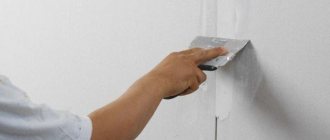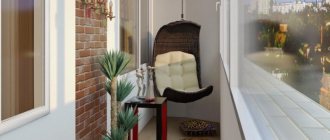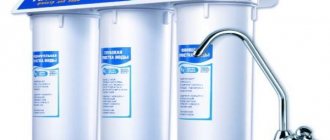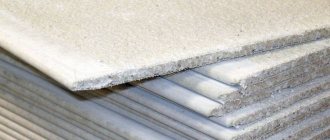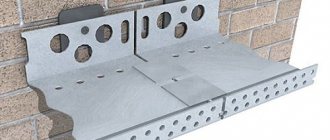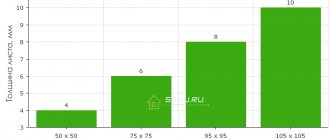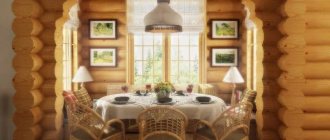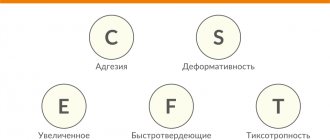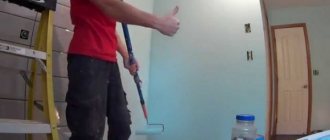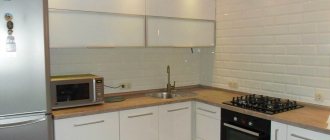It’s rare that a redevelopment can be done without erecting new partitions, unless you decide to make a studio and are just tearing down the old walls. New walls can be built from piece materials, such as brick, slabs and blocks of various compositions - we have already talked about them in the article “From brick to glass blocks: what to build interior partitions from.” Or use sheet materials. There are three most popular today, and we are ready to tell you about all their pros, cons and features so that you can choose the best one.
OSB boards
Oriented strand boards are a more moisture-resistant material than plasterboard. In addition, OSB boards, with their high density, have less weight than plasterboard sheets.
Currently, OSB boards are very often used for wall cladding during the construction of frame houses, as well as as a base for roofing coverings. With their help you can level not only walls, but also the floor surface.
Disadvantages of drywall
Drywall is a fairly versatile material that does not have many disadvantages. The main ones are the following:
- Low strength. By touching the structure, it is easy to damage the sheathing, leaving chips and scratches, and with a strong impact, make a dent or even break through the drywall. To secure heavy objects, it is necessary to provide in advance mortgages made of timber, boards, strips of plywood or chipboard and other materials, or to use fastening devices that distribute the load.
- Low moisture resistance. Although the ability of drywall to absorb excess moisture from the air and release it back when the relative humidity decreases is considered a positive quality, this material is not suitable for use in conditions of direct contact with water. A moisture-resistant version of drywall is available, but it is also designed for certain maximum use parameters. When exposed to high humidity conditions for a long time, mold forms and drywall crumbles.
- Insufficient fire resistance. Belongs to flammability group G1 (low-flammable materials).
Plywood
Drywall is often used simply because it can be neatly bent to create, for example, a door arch. It is noteworthy that sheets of plywood bend even better than sheets of drywall. In addition, plywood is more:
- moisture resistant;
- wear-resistant;
- practical.
The advantages of plywood also include its more attractive appearance. As a result, plywood can replace drywall in a number of cases, from leveling the surface of walls and ceilings, to creating various interior arches, podiums, niches, and so on.
Plank and plaster
Lath and plaster used to be a more labor-intensive surface to install. However, over time the system has evolved and is now a faster and easier form of installation and also makes a good alternative to drywall.
To begin with, the installation of wooden blocks is necessary; in a horizontal position, this forms the area, the lattice, and it forms the basis of the texture. The contractor then uses gypsum plaster, which is applied over the entire lath, pushing it through all the cracks and crevices. The patch is a binding substance called a key.
Chipboard
Chipboards can be compared with oriented strand boards, since the technical and operational characteristics of these materials are almost identical. However, chipboard, unlike OSB, does not tolerate moisture and water well and in this way they are similar to drywall.
However, chipboard deserves attention because it is relatively inexpensive. Chipboard can be used to perform rough work.
Cork wall
Cork board has always been a popular product for many reasons. Most people associate cork board organization. This type of organization is usually located in an office or perhaps a school where messages can be attached and monitored. Well, now you too can ditch the boring drywall and use cork board instead.
There is a large selection of styles, shades, thicknesses and much more. Cork board can be used in any room to create a beautiful texture. Which will look stylish and also help warm up the room and make it really stand out.
GVL
Gypsum fiber sheet is very similar to plasterboard sheet both in its appearance and the raw materials from which it is produced. At the same time, GVL has a couple of advantages, namely higher ones:
- thermal insulation performance;
- soundproofing properties.
GVL plasterboard is also inferior in its fire resistance characteristics. However, GVL are not flexible enough to make the same interior arches from them.
Wooden boards
One of the most popular styles for a farmhouse style home is the wood used throughout the home. Wood is a favorite element used in many different ways throughout homes, from floor to ceiling. Wood planks running along the wall can really warm up a room.
Typically, wood strips installed along a wall are secured using a tongue and groove installation process. You can use your style preferences to create the perfect look for you.
Choose from many different types of wood and wood finishes. Wood planks can be installed immediately and are used by many homeowners as an alternative to drywall.
Tongue-and-groove slabs
PGP are a building block material from which stronger and more reliable walls can be built compared to plasterboard. The advantages of this material include:
- simple installation, which is carried out according to the tongue-and-groove principle;
- Thanks to the presence of grooves, it is possible to perform engineering work, in particular, laying wires and pipes.
The slabs can be used for the construction of interior walls and partitions.
When is replacement needed?
Situations in which it may be necessary to replace such an excellent finishing material do occur, but are quite rare. This is primarily due to the fact that drywall has several disadvantages, which sometimes make it impossible to install it indoors. Such situations include:
Mortgage
- the inability to hang heavy objects on plasterboard walls without preliminary procedures aimed at minimizing stress on the material. Such preparation, for example, includes laying a mortgage under the sheets during wall covering;
- small dimensions of the room, for which those centimeters that will be “stolen” by installation work are important. When finishing the walls, the volume of the room will decrease by at least 5 cm on each side. Therefore, for the bathroom and on the balcony, where there are often problems with free space, an alternative replacement is needed.
As you can see, drywall has a fairly small list of shortcomings, consisting of only two points. But this is enough for there to be alternatives on the market that can be used if necessary.
Glass magnesium sheets
LSU is considered one of the most worthy alternatives to drywall, however, sheets of this material are somewhat more expensive than gypsum board. The advantages of LSU include the best:
- sound insulation;
- moisture resistance;
- thermal insulation;
- strength.
In addition, LSUs have less weight compared to gypsum boards, making them easier to work with.
Reasons for success
Drywall is very often used for finishing walls, ceilings, as well as for assembling partitions and even furniture. Such popularity came to the material due to the following list of its positive qualities:
- long service period;
- simple installation;
- affordability in terms of price;
- the presence of various properties, due to which it can be freely used for various rooms (bathroom, kitchen, bedroom, balcony, etc.);
Note! For each room you should choose a material with specific properties.
- versatility. It can be used for assembling suspended ceiling devices, finishing walls, partitions, etc.;
- 100% environmentally friendly.
As you can see, knowing about such qualities of gypsum board, it will be quite problematic to find an analogue of the material that would have similar advantages. But difficult does not mean impossible!
Aquapanels
They are the newest of the above materials. These panels ideally combine higher indicators compared to gypsum plasterboard:
- fire resistance;
- moisture resistance;
- frost resistance.
Aquapanels can be used to perform not only internal, but also external work. It is noteworthy that these panels are 3 times stronger than drywall.
What material should you choose as an alternative to drywall? There is no definite answer, since much depends on a number of unique factors, criteria and nuances of a particular situation. Be that as it may, there is a choice of alternative options, and the number of options continues to increase, thanks to the development of modern technologies and the emergence of new and sometimes truly innovative materials on the market.
Main characteristics of analogue materials
Tongue-and-groove slabs
GCPs are often positioned as the main analogue of gypsum plasterboards due to the fact that they allow minimizing “dirty” plastering work. GGP is produced from gypsum with additives: binders and antiseptic components. The slabs are produced both solid and hollow. They are distinguished by high strength and excellent sound insulation qualities, providing an optimal indoor microclimate.
Related article: Why doesn’t the washing machine rinse and what to do?
Related articles: Laminated drywall
Chipboard and OSB
Features of use! Chipboards are characterized by low moisture resistance, so they are used only in dry rooms. OSB and chipboard are difficult to plaster for subsequent painting.
Glass magnesite sheets
Consist of minerals, fiberglass and fine sawdust.
This is what glass magnesite products look like
Advantages of LSU:
- Fire resistance - glass-magnesium sheets are installed in rooms where only non-combustible materials can be used (for example, for finishing emergency exits, etc.).
- Safety - there are no toxic additives, which allows the use of magnesite boards in children's institutions, hospitals, canteens, etc.
- LSU is an excellent replacement for plasterboard; it has high strength qualities and flexibility: thanks to these characteristics, a variety of complex structures can be created from LSU.
Excellent flexibility with high strength properties
- Excellent sound insulation properties provide a wide range of applications for glass-magnesium slabs in the finishing of cinemas and other rooms where it is necessary to isolate loud sounds.
- Excellent moisture resistance allows installation of LSU in rooms with high humidity: bathrooms and even saunas.
- Frost resistance is an important quality. This allows the products to be used in exterior decoration. The material can withstand temperature changes without deforming. Any surfaces can be covered, awnings and canopies can be finished, and a base for a soft roof can be laid.
Important! In the external environment, slight linear expansion of the material is possible. This leads to the appearance of cracks at the joints. There are many methods to combat this phenomenon.
LSU and for external cladding is indispensable
This drywall substitute has a smooth surface on one side and rough on the other. Glass-magnesite sheet does not require preliminary preparation. Any decorative coating can be easily applied to a smooth surface: paint and plaster, tiles and wallpaper.
Important! It is not advisable to paint with waterproof paint (over time, blisters may appear on the surface).
Rules for installing glass-magnesium panels
These products do not require special installation and processing skills - all work can be done with your own hands. For these manipulations you will need standard tools:
- knife,
- jigsaw,
- narrow hacksaw,
- plane,
- screwdriver or drill,
- spatulas.
With internal cladding, fastening is carried out on a metal or wooden fastening system, or directly on the enclosing structure. When the installation instructions are strictly followed, you can guarantee that the finish will delight you with its impeccable appearance for many years.
Visual photo of installation work
They are cut with a hand jigsaw, circular saw, polished with a grinding machine, and do not form cracks or chips during processing. During the cutting process, the slabs lie on the floor, cutting is carried out from the glossy side.
Important! In order for the cutting to be done efficiently, you need to use a dry sheet.
